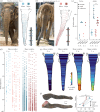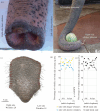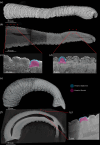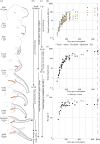Elephants develop wrinkles through both form and function
- PMID: 39386989
- PMCID: PMC11461087
- DOI: 10.1098/rsos.240851
Elephants develop wrinkles through both form and function
Abstract
The trunks of elephants have prominent wrinkles from their base to the very tip. But neither the obvious differences in wrinkles between elephant species nor their development have been studied before. In this work, we characterize the lifelong development of trunk wrinkles in Asian and African elephants. Asian elephants have more dorsal major, meaning deep and wide, trunk wrinkles (approx. 126 ± 25 s.d.) than African elephants (approx. 83 ± 13 s.d.). Both species have more dorsal than ventral major trunk wrinkles and a closer wrinkle spacing distally than proximally. In Asian elephants, wrinkle density is high in the 'trunk wrapping zone'. Wrinkle numbers on the left and right sides of the distal trunk differed as a function of trunk lateralization, with frequent bending in one direction causing wrinkle formation. Micro-computed tomography (microCT) imaging and microscopy of newborn elephants' trunks revealed a constant thickness of the putative epidermis, whereas the putative dermis shrinks in the wrinkle troughs. During fetal development, wrinkle numbers double every 20 days in an early exponential phase. Later wrinkles are added slowly, but at a faster rate in Asian than African elephants. We discuss the relationship of species differences in trunk wrinkle distribution and number with behavioural, environmental and biomechanical factors.
Keywords: Proboscidea; ageing; development; morphology; ontogeny.
© 2024 The Author(s).
Conflict of interest statement
We declare we have no competing interests.
Figures







Similar articles
-
Elephant trunks use an adaptable prehensile grip.Bioinspir Biomim. 2023 Feb 8;18(2). doi: 10.1088/1748-3190/acb477. Bioinspir Biomim. 2023. PMID: 36652720
-
Elephant facial motor control.Sci Adv. 2022 Oct 28;8(43):eabq2789. doi: 10.1126/sciadv.abq2789. Epub 2022 Oct 26. Sci Adv. 2022. PMID: 36288305 Free PMC article.
-
The functional anatomy of elephant trunk whiskers.Commun Biol. 2023 Jun 8;6(1):591. doi: 10.1038/s42003-023-04945-5. Commun Biol. 2023. PMID: 37291455 Free PMC article.
-
Acknowledging the Relevance of Elephant Sensory Perception to Human-Elephant Conflict Mitigation.Animals (Basel). 2022 Apr 14;12(8):1018. doi: 10.3390/ani12081018. Animals (Basel). 2022. PMID: 35454264 Free PMC article. Review.
-
The wrinkle and its measurement--a skin surface Profilometric method.Micron. 2004;35(3):201-19. doi: 10.1016/j.micron.2003.11.007. Micron. 2004. PMID: 15036275 Review.
Cited by
-
Second harmonic generation imaging reveals entanglement of collagen fibers in the elephant trunk skin dermis.Commun Biol. 2025 Jan 8;8(1):17. doi: 10.1038/s42003-024-07386-w. Commun Biol. 2025. PMID: 39779804 Free PMC article.
-
Effect of the habitat and tusks on trunk grasping techniques in African savannah elephants.Ecol Evol. 2024 Apr 19;14(4):e11317. doi: 10.1002/ece3.11317. eCollection 2024 Apr. Ecol Evol. 2024. PMID: 38646004 Free PMC article.
References
-
- Reveyaz N, et al. . 2024. A myelin map of trunk folds in the elephant trigeminal nucleus. Elife 13 , RP94142. (10.7554/eLife.94142.3) - DOI
Associated data
LinkOut - more resources
Full Text Sources

